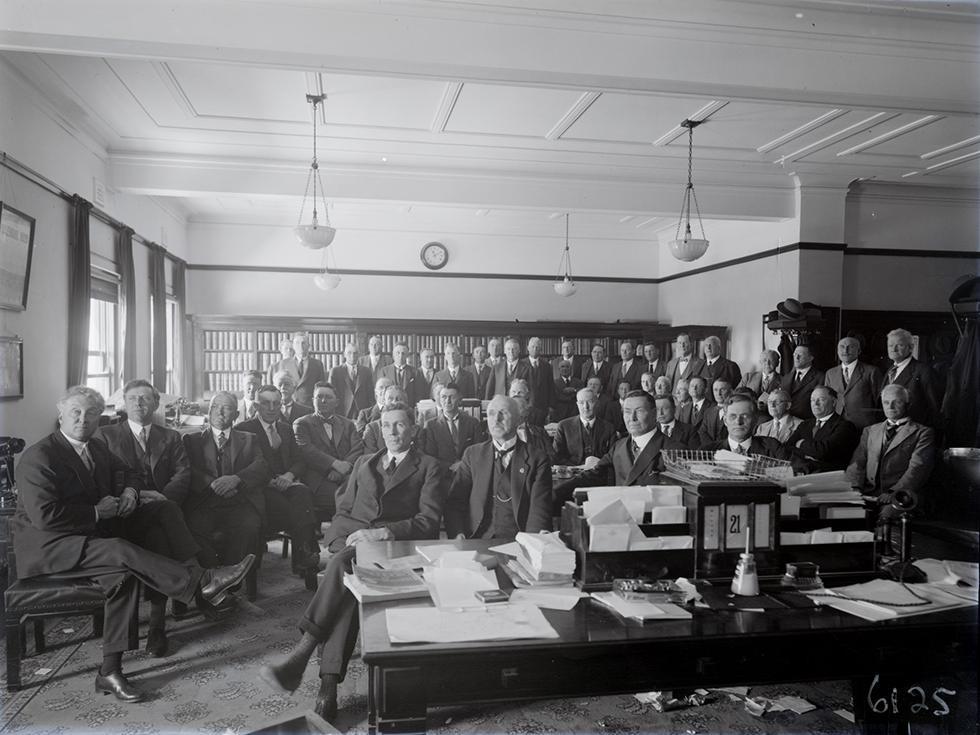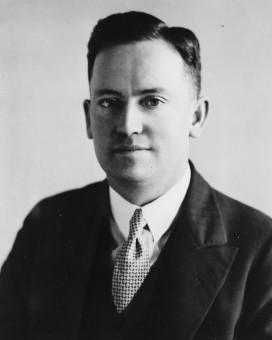John Curtin contested 10 federal elections in 20 years. In 1914 and 1919, he stood unsuccessfully for safe conservative seats. His first attempt in 1925 to win the seat of Fremantle was also unsuccessful. He won the seat of Fremantle 6 times, in 1928, 1929, 1934, 1937, 1940 and 1943. He lost the seat in 1931, but regained it in 1934.

The ministry of James Scullin and newly elected Labor members of the 16th parliament, 21 October 1929, with Joseph Lyons, Ben Chifley and John Curtin in front. NAA: A3560, 6125
5 September 1914
Australia’s first double dissolution election was also Curtin’s first. He stood unsuccessfully for Balaclava, against Premier of Victoria William Watt. Andrew Fisher became Prime Minister for the third time when Labor government won 42 seats in the House of Representatives to 32 Deakinite Liberal seats.
13 December 1919
Curtin again stood unsuccessfully, this time for the conservative seat of Perth. The Nationalist government of William Hughes was returned with 37 seats in the House of Representatives, 26 Labor seats and 1 ‘Independent Nationalist’. After this election the representatives elected by farmers’ groups formed the Country Party.
14 November 1925
At this election Curtin made his first serious bid for a parliamentary seat, standing unsuccessfully for the seat of Fremantle. The government of SM Bruce was returned with 37 Nationalist seats in the House of Representatives. Their Country Party coalition partners won 14 seats and Labor 23, with 1 Independent. In the Senate, 18 Nationalist and 4 Country Party Senators were elected. This was the first federal election where voting was compulsory, and over 90% of those eligible voted.
17 November 1928
Curtin won the seat of Fremantle at this election, but the Bruce government held office with the House of Representatives made up of 29 Nationalists and 13 Country Party members to Labor’s 31 seats. The ‘Country Progressive Party’ won 1 seat and there was 1 Independent. In the Senate, Labor won 7 Senate seats, the Nationalist Party 10 and the Country Party 2.
12 October 1929
Curtin retained Fremantle and a Labor government led by James Scullin was returned in a ‘landslide’ victory, with 46 seats won by Labor, to 14 Nationalist, 3 ‘Independent Nationalist’, 1 Independent and 10 Country Party seats in this House of Representatives election.
19 December 1931
Curtin lost the Fremantle seat and the Scullin government fell after a split in the Labor Party. Labor held 14 seats and the ‘Lang’ Labor group 4, with 34 seats won by the new United Australia Party led by JA Lyons after his defection from the Labor Party. The Country Party won 16 seats, there was 1 Independent, and 6 ‘Emergency Committee’ (South Australia). In the Senate, the United Australia Party won 15 seats and Labor 3. This was the first federal election contested by the Communist Party.
15 September 1934
The Lyons government remained in office with the United Australia Party winning 28 seats, the Country Party 14, 5 Liberal and Country League (South Australia), with 18 Labor and 9 ‘Lang’ Labor seats. In the 1934 Senate election, the United Australia Party won 16 seats and the Country Party 2. Curtin regained the seat of Fremantle.
23 October 1937
The Labor Party, led by John Curtin, won 29 seats, but the Lyons government was returned with 28 United Australia Party seats, 1 ‘Independent UAP’ and 16 seats for their Country Party coalition partners in the House of Representatives. Labor gained 16 Senate seats, with the United Australia Party winning only 3.
21 September 1940
The United Australia Party, led by Prime Minister Robert Menzies, narrowly retained a coalition government. The United Australia Party won only 23 seats to Labor’s 32, with 14 Country Party, 4 ‘Lang Labor’ – Non-Communist Labor Party seats and 1 Independent. The United Australia Party and Country Party won 16 Senate seats, and Labor won 3.
On 28 August, Menzies was replaced as Liberal leader, and Country Party leader Arthur Fadden became Prime Minister. Fadden was unable to retain majority support in the House of Representatives and, on 7 October 1941, John Curtin became Prime Minister.
21 August 1943
The Curtin government was returned with a convincing majority, winning 49 seats to 12 United Australia Party, 7 Country Party, 3 Country National Party (Queensland), 1 Queensland Country Party, 1 Liberal Country Party (Victoria) and 1 Independent in the House of Representatives. The Labor Party also won all 19 Senate seats contested.
Sources
These brief election results relate only to this Prime Minister. They are drawn from the online sources below, where further information can be found.
Australian Electoral Commission: Election results
University of Western Australia: Australian Government and Politics Database





